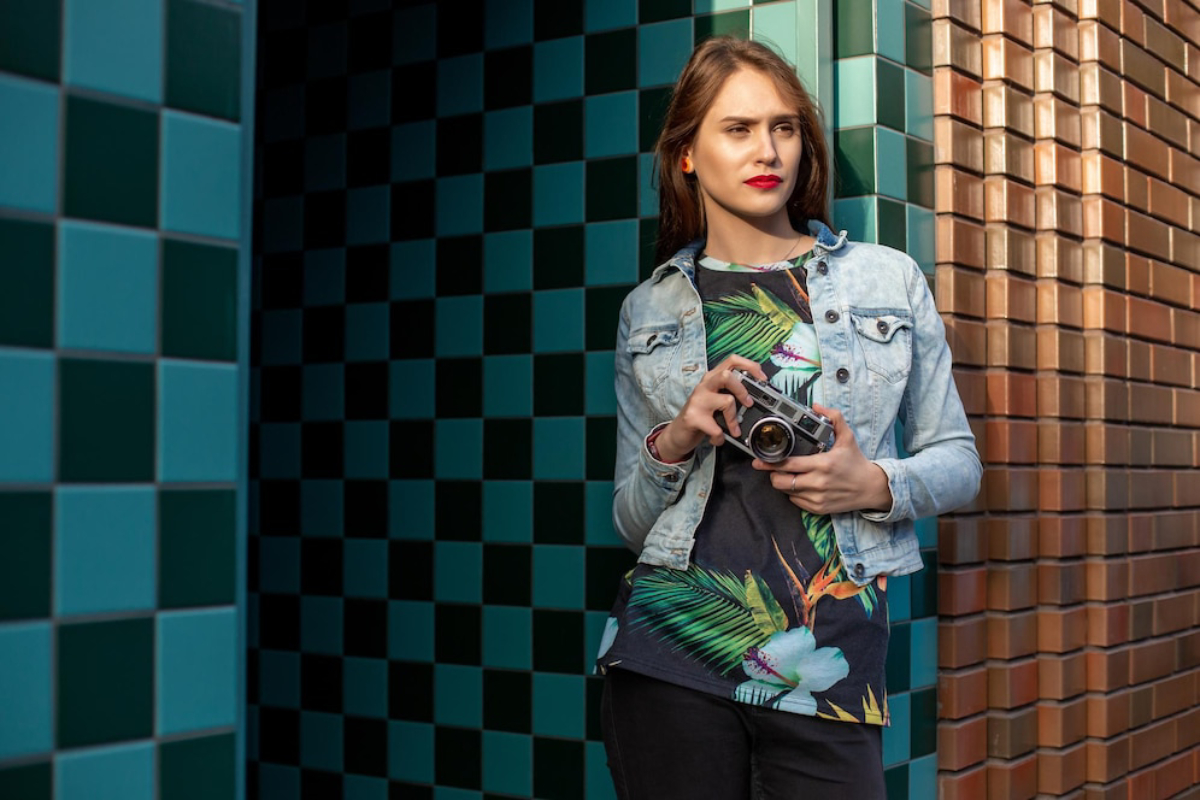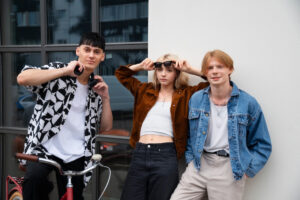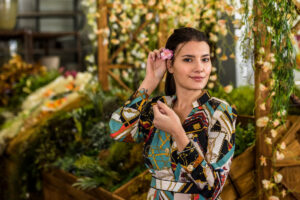The Fashion Blog

How to Mix and Match Patterns Like a Pro
Pattern mixing is a thrilling playground for your personal style. Whether you’re a fashion aficionado or simply seeking to spice up your wardrobe, mastering this art can transform your outfits from drab to dazzling. Yet, many retreat from this fashionable frontier, fearing a cacophony of prints that clash rather than harmonise.
Enter our pattern-mixing guide, your compass, in this colourful journey. Here, you’ll uncover the essential principles for crafting outfits that sing in stylish harmony. Learn to clash prints with flair while keeping your look polished and cohesive. You’ll strut confidently by the end, ready to experiment with vibrant patterns, layering styles, and eye-catching accessories.
We’ll uncover common pitfalls to avoid and answer your burning questions about styling prints like a pro. Embrace your inner fashionista, and let’s dive into this world of vibrant possibilities!
The Basics of Pattern Mixing

Before diving into advanced styling tips, it’s essential to understand the fundamentals of mixing prints. Here are some key principles to keep in mind:
1. Stick to a Common Colour Palette
One of the easiest ways to mix patterns is by ensuring they share at least one standard colour. This creates a visual link between the prints, making them appear intentional rather than chaotic.
For example:
- Pairing a navy and white striped top with a navy floral skirt creates a harmonious balance.
- For a seamless look, a beige polka dot blouse can be paired with a beige and brown checkered skirt.
- A black-and-white houndstooth jacket over a black-and-white floral dress can create an effortlessly chic ensemble.
A monochromatic approach also works well for beginners. Sticking to black, white, grey, or beige prints can help you ease into pattern mixing without feeling overwhelmed.
2. Vary the Scale of Patterns
Mixing patterns of different sizes helps avoid overwhelming the eye. A general rule is to combine a large-scale pattern with a smaller one. This ensures that one print remains dominant, creating a balanced and visually appealing outfit.
Examples:
- A bold, oversized floral print skirt with a delicate, subtle polka dot blouse.
- Thick horizontal stripes paired with a finely detailed paisley print.
- Large geometric prints mixed with tiny gingham patterns.
3. Use Neutral Prints as Anchors
Neutral prints, such as stripes, polka dots, and plaids, are great balancing elements when mixing bolder patterns. They serve as a foundation that makes the more striking prints stand out.
Some versatile neutral patterns include:
- Black-and-white stripes
- Classic gingham
- Small polka dots
- Subtle houndstooth
Stripes, in particular, work well with almost any pattern. A striped t-shirt can be paired with florals, animal prints, or geometric designs without looking mismatched.
Advanced Pattern Mixing Techniques

Once you’re comfortable with the basics, you can start experimenting with more daring combinations. Here are some expert-approved techniques to take your pattern-mixing game to the next level.
1. Mix Different Types of Prints
Rather than sticking to one type of print, try combining different categories. Some of the most stylish combinations include:
- Floral + Stripes: The contrast between structured lines and organic floral patterns creates a visually appealing outfit.
- Animal Print + Geometric Print: Leopard or zebra prints work well with bold checks or abstract designs.
- Plaid + Polka Dots: The structure of plaid balances the playful, whimsical feel of polka dots.
- Camouflage + Stripes: Military-style prints combined with classic stripes can create an edgy, modern look.
2. Experiment with Textures
Mixing textures adds depth to your outfit, making pattern combinations more visually engaging. Consider pairing:
- A tweed plaid blazer with a silky floral dress.
- A knitted striped jumper with a smooth satin polka dot skirt.
- A corduroy leopard print jacket over a lightweight, flowing chiffon dress.
By incorporating different materials, you can create a multi-dimensional look that is both stylish and sophisticated.
3. Incorporate Accessories
If you’re hesitant to go full-on with mixed prints, start small with accessories:
- A patterned scarf can introduce a subtle mix to a monochrome outfit.
- Patterned shoes or handbags can add an interesting twist without overwhelming the look.
- A printed belt can break up solid colours while complementing another patterned element.
Accessories are an excellent way to ease into pattern mixing while still keeping your outfit balanced and stylish.
4. Play with Layering
Layering different patterns is an advanced technique that can add sophistication to your outfit. Consider wearing a patterned blazer over a printed dress or layering a floral blouse under a checkered sweater.
For example:
- A striped turtleneck under a plaid blazer creates a refined yet trendy look.
- A polka dot shirt layered under a floral slip dress adds contrast without overwhelming the ensemble.
Common Pattern Mixing Mistakes to Avoid
Even the most stylish individuals can sometimes make mistakes when experimenting with prints. Here are a few pitfalls to avoid:
1. Overloading with Too Many Prints
Mixing more than two or three patterns can create visual chaos. Stick to a maximum of three prints per outfit to keep the look intentional and refined. If you’re unsure, use one statement pattern and pair it with more subtle prints.
2. Ignoring Proportions
Avoid combining patterns of the same scale, which can make the outfit look too busy. Instead, mix large, medium, and small-scale prints for balance.
3. Not Considering Occasion or Setting
While bold pattern combinations can be fun, some settings require a more subtle approach. Opt for muted tones and classic patterns like pinstripes or houndstooth for professional or formal environments.
4. Mismatched Colour Schemes
A lack of colour coordination can make even the best pattern combinations look messy. Always consider a cohesive colour palette when mixing prints to ensure a harmonious outfit.
FAQs About Mixing Patterns
Can I mix patterns if I prefer a minimalist style?
Yes! Stick to monochrome patterns or subtle prints like tone-on-tone textures for a minimalist yet stylish approach. Black-and-white stripes, neutral plaids, and soft polka dots are great options for maintaining a clean aesthetic.
What’s the easiest pattern combination for beginners?
Start with stripes, florals, checks, and polka dots—they are foolproof combinations that always look chic. Keeping one pattern in a neutral shade can also make the pairing feel less overwhelming.
How do I mix patterns in winter outfits?
Layering is key! Paid coat over a striped turtleneck, paired with a subtly patterned scarf, is a tremendous winter-ready look. Incorporating different textures, like knitwear with silk, can also enhance your ensemble.
Is there a pattern that goes with everything?
Yes! Stripes are one of the most versatile patterns and can be paired with almost any print. Black-and-white stripes, in particular, work well with florals, polka dots, and animal prints.
Playing with Fashion
Mixing and matching patterns is a vibrant art form that lets your creativity and personality shine through fashion. With this pattern-mixing guide in hand, you can clash prints fashionably. Forget about mismatched looks; it’s time to embrace delightful disarray! Dive into experimentation, savour the fun, and revel in your unique style!
Ready to upgrade your wardrobe with stunning print combinations? Start experimenting today, and don’t forget to share your stylish looks with us!









